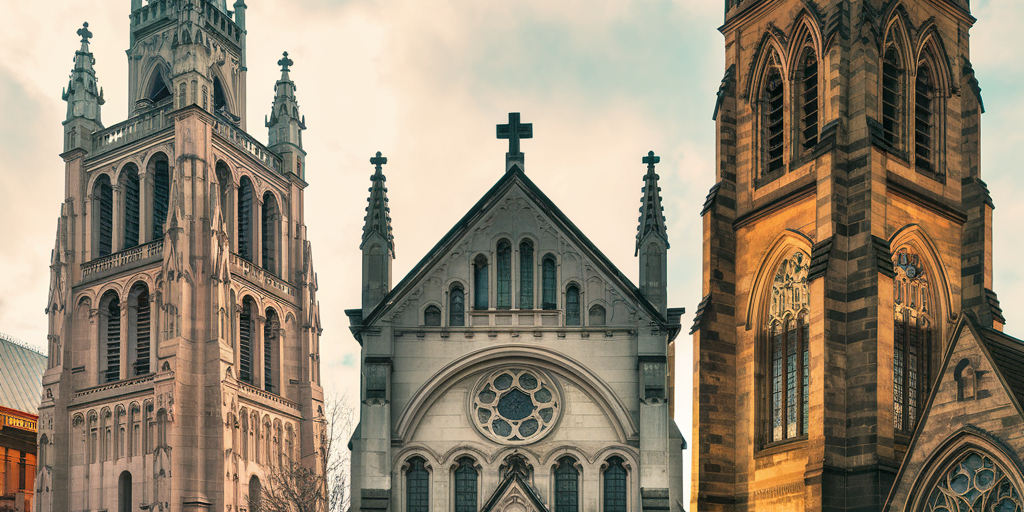The Spiritual Backbone of Pittsburgh’s History
Pittsburgh’s most beautiful churches rise above the city’s steel and glass skyline, their Gothic spires and grand cathedrals telling stories that span centuries. These historic churches in Pittsburgh showcase stunning architectural masterpieces—from soaring stone cathedrals with intricate stained glass to hidden chapels housing sacred relics. Each represents the faith, artistry, and immigrant heritage that shaped this great city.
In this guide, we’ll explore Pittsburgh’s most beautiful churches, from the oldest active church site to Gothic revival cathedrals that rival Europe’s finest.
St. Paul Cathedral – Oakland’s Gothic Masterpiece
The Heart of Pittsburgh’s Catholic Community
Located in Oakland, St. Paul Cathedral is one of Pittsburgh’s most recognizable religious landmarks. Completed in 1906, the cathedral was designed in the Gothic Revival style by architect Egan & Prindeville of Chicago.
The cathedral features:
- Soaring spires that rise 247 feet into the air
- Intricate stained glass windows imported from Germany
- Carved stone detailing that rivals Europe’s finest cathedrals
St. Paul became the mother church of the Roman Catholic Diocese of Pittsburgh, serving the spiritual needs of thousands of Catholic immigrants who arrived in the city during the industrial boom. Its grandeur reflects the importance of faith in Pittsburgh’s immigrant communities, especially Irish, Italian, and Polish populations who helped fund and build the cathedral.
Today, St. Paul continues to host major diocesan events, weddings, and daily mass, making it a vibrant part of Pittsburgh’s religious and architectural heritage.
St. Anthony’s Chapel – Home to One of the Largest Relic Collections Outside the Vatican
A Hidden Gem in Troy Hill
Nestled in the Troy Hill neighborhood, St. Anthony’s Chapel is a true treasure of Pittsburgh. Built in 1880 by Father Suitbert Mollinger, a wealthy Capuchin friar and physician, the chapel was designed to house his incredible collection of religious relics.
Today, St. Anthony’s boasts:
- Over 5,000 relics, making it the largest collection outside of the Vatican
- Life-sized Stations of the Cross imported from Munich, Germany
- Stunning Gothic architecture with vaulted ceilings and ornate altars
The chapel became a place of pilgrimage for Catholics and remains one of the most unique historic churches in Pittsburgh. Its rich collection includes relics of saints, apostles, and even a fragment of the True Cross, connecting visitors to centuries of Christian history.
St. Anthony’s Chapel is still active, offering regular mass, tours, and a glimpse into Pittsburgh’s deeply spiritual past.
Trinity Cathedral – Pittsburgh’s Oldest Church Site
A Protestant Landmark with Deep Roots
Located downtown, Trinity Cathedral is one of the oldest and most historically significant religious sites in Pittsburgh. While the current Gothic Revival building was completed in 1872, the site has served as a place of worship since 1787, making it the city’s oldest active church site.
Key features include:
- A Gothic sandstone exterior inspired by English cathedrals
- Historic graveyard dating back to the 18th century
- Intricate stained glass windows and hand-carved woodwork
Trinity Cathedral has deep connections to Pittsburgh’s earliest settlers, including British, Scots-Irish, and German immigrants. It stood through the city’s transformation from a frontier town to an industrial giant. Today, Trinity remains a vibrant Episcopal congregation and a vital piece of Pittsburgh’s religious history.
Other Notable Historic Churches in Pittsburgh
Pittsburgh is home to dozens of other historic churches that showcase the city’s rich religious and cultural tapestry:
- St. Stanislaus Kostka Church (Strip District): Built in 1891, serving Pittsburgh’s Polish Catholic communitywith stunning stained glass and hand-painted murals.
- First Presbyterian Church (Downtown): Completed in 1905, known for its Tiffany stained glass windowsand Gothic architecture.
- Calvary Episcopal Church (Shadyside): Designed by Ralph Adams Cram, featuring English Gothic Revival design and massive stained-glass masterpieces.
- Immaculate Heart of Mary (Polish Hill): A grand church serving Pittsburgh’s Polish immigrants, known for its massive dome and elaborate interiors.
The Cultural and Architectural Legacy of Pittsburgh’s Churches
These historic churches in Pittsburgh do more than serve as places of worship. They are:
- Architectural landmarks reflecting styles from Gothic Revival to Romanesque
- Cultural hubs that preserved languages, traditions, and communities
- Historical records of the immigrants who built Pittsburgh’s industries and neighborhoods
From Irish, Italian, Polish, and German Catholic churches to Protestant cathedrals, these structures symbolize the faith and perseverance of Pittsburgh’s diverse population.
Today, many of these churches are open to visitors, offering tours, services, and events that keep their legacy alive.
Pittsburgh’s Churches as Living History
The historic churches in Pittsburgh are more than stone and stained glass—they are living monuments to the city’s rich cultural past. Whether you’re exploring St. Paul Cathedral’s Gothic beauty, marveling at St. Anthony’s vast relic collection, or walking the historic grounds of Trinity Cathedral, these sacred spaces tell the story of Pittsburgh’s soul.
For history buffs, architecture lovers, or anyone seeking a deeper connection to the city, Pittsburgh’s churches offer a timeless journey through faith, art, and community.








